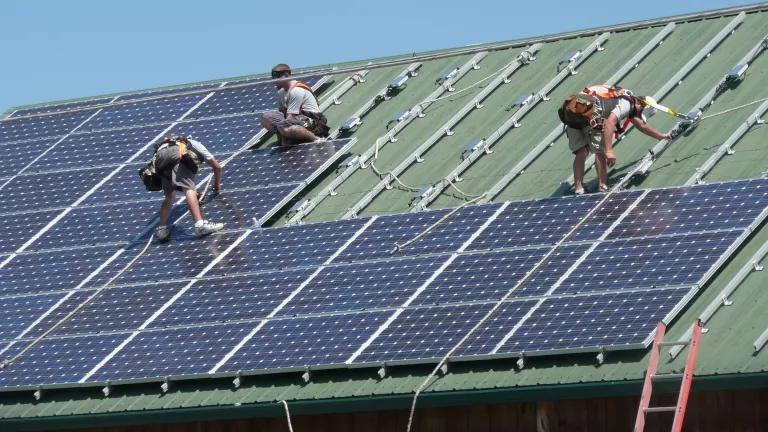
Affordable housing and environmental groups, including NRDC, are urging the California Public Utilities Commission to adopt a groundbreaking proposal to put solar panels on the roofs of affordable housing under the state’s new solar law. Our proposal also includes robust energy efficiency requirements and energy storage that will bring even more benefits to low-income tenants.
When operational in 2017, the Multifamily Affordable Solar Roofs program (AB 693) would provide up to $1 billion in solar funding over 10 years and will be the first in the country specifically designed to provide low-income renters with (1) increased access to onsite solar-generated electricity and (2) direct economic benefits via solar electricity credits.
The law targets installation of 300 megawatts (MW) of solar energy, which, if accomplished, would fully power the equivalent of 75,000 California homes.
The Natural Resources Defense Council—together with leading housing and environmental groups California Housing Partnership, California Environmental Justice Alliance, Brightline Defense Project, and National Housing Law Project—last week urged the California Public Utilities (CPUC) to adopt our joint proposal, which would produce even more savings once you factor in energy efficiency and storage. With a requirement to cut energy waste by 15 percent for participating buildings, the equivalent of another 11,250 homes could be powered with electricity on an annual basis.
Solar companies, utilities and others also submitted separate proposals last week.
The Multifamily Affordable Solar Roofs law
Funded from revenues from California’s cap-and-trade auctions under the state’s pioneering Global Warming Solutions Act, the Affordable Solar Roofs Program (AB 693) will bring the benefits of California’s clean energy policies to communities suffering disproportionately from pollution and provide an economic stimulus in low-income neighborhoods.
Nonprofit solar coalition proposal
Our joint proposal requests that the CPUC adopt an integrated program that combines energy efficiency, solar PV (photovoltaic) panels, and energy storage devices. These would reduce energy use, electric system peak load demands, and costs while advancing utility efforts to transition to a smarter energy grid.
We further recommend providing job opportunities and targeting solar energy system installations in low-income and disadvantaged communities through a single, state-wide administrator.
Adoption of energy efficiency proposal fundamental to success
Our joint proposal urges the CPUC to set a strong energy efficiency requirement—a 15 percent reduction per property—to further cut tenant bills and ensure available solar funds reach as many households as possible. By cutting electricity use, energy efficiency can enable PV systems to be downsized, thereby allowing available solar funding to go further. We propose funding support, flexibility, and smart program design to ensure the efficiency requirement provides straightforward benefits to owners and tenants without additional hassle.
Given the size and breadth of the Affordable Solar Roofs program, it would be a waste of customer funds—and greenhouse gas emissions—if owners were not offered an integrated package of clean energy options. With the bewildering amount of available clean energy programs, it’s also imperative that this program present owners and tenants with a single, cohesive offering from the start.
Our joint proposal recommends the CPUC integrate efficiency into the overall program design and leverage multiple funding sources to ensure owners can meet the 15% target. Specifically, our proposal includes:
- A comprehensive, whole-building audit (ASHRAE Level II or above) and implementation plan
- A three-year flexibility provision to complete identified improvements and ensure installation of solar resources is not delayed
- Alternative compliance mechanisms to meet the 15 percent efficiency requirement, e.g. proof of a recent retrofit or meeting a set Energy Usage Intensity benchmark (measured by energy usage divided by square footage)
- Full technical and programmatic support for building owners
- Funding support via existing programs and an additional fund that leverages one or more of the following sources:
- Unspent AB 693 program funding
- New funding under California Public Utilities Code section 748.5
- Energy Savings Assistance Program general or unspent funds (which total nearly $400 million between 2009-2015)
- Customer-funded state energy efficiency program general or unspent funds.
In addition to providing greater benefits to affordable housing tenants, our energy efficiency proposal would contribute to meeting the state’s climate and clean energy goals and laws, including the SB 350 requirement to double California’s statewide energy savings goals by 2030.
Interested parties have until August 16 to respond to submitted proposals and comments. A final CPUC decision is expected later this year.



